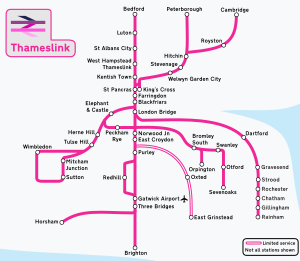Thameslink
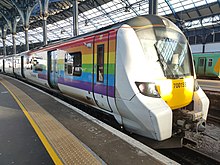 | |||||
| Overview | |||||
|---|---|---|---|---|---|
| Locale | |||||
| Predecessor |
| ||||
| Current operator(s) | Govia Thameslink Railway,14 September 2014 –1 April 2028[1] | ||||
| Website | www | ||||
| Route | |||||
| Termini | |||||
| Train number(s) | TL | ||||
| Line(s) used | |||||
| Technical | |||||
| Rolling stock | 115Class 700Desiro City | ||||
| Track gauge | 1,435 mm(4 ft8+1⁄2in)standard gauge | ||||
| Electrification | |||||
| Track owner(s) | Network Rail | ||||
| |||||
Thameslinkis a mainline route on theBritish railway network,running fromBedford,Luton,St Albans City,Peterborough,Welwyn Garden City,London BlackfriarsandCambridgevia central London toSutton,Orpington,Sevenoaks,Rainham,Horsham,Three Bridges,BrightonandEast Grinstead.The network opened as a through service in 1988, with severe overcrowding by 1998, carrying more than 28,000 passengers in the morning peak. All the services are currently operated byGovia Thameslink Railway.Parts of the network, fromBedfordtoThree Bridges,run 24 hours a day, except on early Sunday mornings and during maintenance periods.[2]
TheThameslink Programmewas a major £5.5billion scheme to increase capacity on the central London section by accommodating more frequent and longer trains, and providing additional routes and destinations. The new services began operating in 2018. In 2016, newClass 700trains started operating on the route and replaced theClass 319,Class 377andClass 387trains which were withdrawn and transferred elsewhere.
Route
[edit]Much of the original route is over theBrighton Main Line(via London Bridge) and the southern part of theMidland Main Line,plus a suburban true loop (circuit) serving Sutton. A branch via theCatford Loop Lineto Sevenoaks was added in 2012. Sections toPeterboroughon theEast Coast Main Line,Cambridgevia theCambridge Line,Horshamon theArun Valley lineandRainhamviaGreenwichwere added in 2018.East Grinsteadis also served during peak hours.
The route through central London (today known as Thameslink core) is viaSt Pancras Internationalfor connections toEurostarand the East Midlands;Farringdon,forLondon UndergroundCircle,MetropolitanandHammersmith & Citylines, and theElizabeth line;City Thameslink,which replaced the demolishedHolborn Viaduct stationand has a southern entrance serving Ludgate Circus;Blackfriars,for main-line rail services and the UndergroundDistrictand Circle lines; andLondon Bridgefor main-line links into Kent and Sussex and the UndergroundNorthernandJubileelines.King's Cross ThameslinkonPentonville Roadclosed on 8 December 2007.
Trains operating the "main line" service (Bedford and Cambridge to Brighton, Peterborough to Horsham) include first-class accommodation; those operating from Luton, St Albans and Kentish Town to Sutton, Sevenoaks and Orpington are usually standard class only. WhenGoviaoperated theoriginal Thameslink franchisethese services were designated "Thameslink CityFlier" and "Thameslink CityMetro" respectively, butFirst Capital Connectdropped this branding.Govia Thameslink Railwaynow refers to these services as Route TL1 (formerly Route 6) and Route TL2/TL3 (formerly Route 7/8) respectively.
Services
[edit]Off-peak
[edit]The Monday–Friday off-peak service pattern, with frequencies intrains per hour(tph), includes:
| Route | tph | Calling at |
|---|---|---|
| BedfordtoBrighton[2][3] | 2 | |
| Bedford to Three Bridges via Redhill[2][4] | 2 |
|
| PeterboroughtoHorshamviaRedhill[5][6] | 2 |
|
| CambridgetoBrighton[5][3] | 2 |
|
| London Blackfriars toSevenoaksvia Catford and Otford[7] | 2 | |
| Luton toRainhamvia Greenwich[7][8] | 2 |
|
| St Albans City toSuttonviaWimbledon(loop)[2][9] | 2 |
|
| St Albans City to Sutton viaMitcham Junction(loop)[2][9] | 2 |
|
Peak hours
[edit]During peak hours, the two trains per hour London Blackfriars to Sevenoaks service (from the table above) is extended through the 'core tunnel' to/fromWelwyn Garden City(though a few services originate at Finsbury Park), with extra calls at City Thameslink, Farringdon, St Pancras International, Finsbury Park,New Southgate,Oakleigh Park,New Barnet,Potters BarandHatfield.[7][10]
As well as these services, during peak hours, several trains in each direction (approximately two trains per hour) run to/fromOrpington(originating/terminating at either London Blackfriars, Luton, West Hampstead Thameslink or Kentish Town), all calling atPetts Woodin lieu of stations from St Mary Cray to Bat & Ball.[7]
In addition, there are six trains per day in each direction that operate to/fromEast Grinstead(originating/terminating at either Bedford, West Hampstead Thameslink, St Pancras International or London Bridge), which, after calling at South Croydon, call atSanderstead,Riddlesdown,Upper Warlingham,Woldingham,Oxted,Hurst Green,LingfieldandDormans.[11]
History
[edit]Passenger services operated across London through theSnow Hill Tunnelfrom mid-Victorian timesuntilWorld War I,when services terminated atMoorgatefrom the Midland line to the north, and atHolborn Viaductfrom the south, at a time when most inner cross-London traffic had been lost to buses and trams. There were low-level platforms under the main part of Holborn Viaduct station known as the Snow Hill platforms: these can still be seen when leaving City Thameslink station travelling northwards.
On 14 June 1941, railway managerGeorge Dowproposed in an article in the London evening newspaperThe Starthat new routes be built in tunnels from Marylebone south to Victoria, and from King's Cross south to Charing Cross. Both were to connect with a Paddington–Liverpool Street tunnel that he proposed, anticipatingCrossrailby 40years. He also proposed a north-east to south-west such link (Liverpool Street to Charing Cross), all giving seamless, key, main-line connections.[12]
The Snow Hill Tunnel route remained open for cross-London freight trains until 1970, when the short section between Farringdon and Holborn Viaduct was closed.
Overhead electrification, completed in 1982, allowed the northern section to run as theMidland City LinefromBedfordvia theMidland Main LinetoSt Pancras,and via theCity Widened LinestoMoorgate.[a]
TheSnow Hill tunnelwas re-opened byBritish Railto passenger trains after 72years, with Thameslink beginning in May 1988.[13]On 29 January 1990, the section between Blackfriars and Farringdon was temporarily closed to permit the construction of a new alignment. The route through the site of the long-closedLudgate Hill station,over Ludgate Hill toHolborn Viaductwas abandoned and demolished. The replacement route under Ludgate Hill was opened on 29 May 1990 by theNetwork SouthEast(sector ofBritish Rail) concurrently withCity Thameslinkstation, which was initially called St Paul's Thameslink but was renamed in 1991 to avoid confusion withSt. Paul's stationon the Underground (Central line), about 500 m (550 yd) away.
King's Cross ThameslinkonPentonville Roadclosed on 8 December 2007, when the Thameslink platforms at nearbySt Pancrasopened.
In the south the services divide: many main-line trains run almost due south throughLondon BridgetoEast Croydonand many continue toBrighton,but the other route/branch has evolved, as follows:
- From 1988 to 1991 such trains went variously
- via Bromley: to Orpington or to Sevenoaks, (both since resumed) or;
- via Herne Hill and East Croydon to Purley (off peak only).
- From 1991 to 1994, such trains went only viaElephant & CastleandStreathamtoWest Croydon,Carshalton Beeches,Sutton,Epsom,LeatherheadandEffingham Junction,toGuildford.
- From 1994 to 1995 such trains terminated at West Croydon (cutting franchise zone-crossing due torail privatisation).
- From the latter year such trains have run "to/from" a nominal furthest point of a true circular loop,Sutton,theSutton loopcalling at stations includingMitcham Junction,Streatham andWimbledon.
- From 2018 the service was greatly recast and expanded following the completion of theThameslink programme:
- A regular service to Rainham has been added.
- A regular service to Horsham has been added.
- In the north the present termini of the trains are Luton, Bedford, Cambridge, Peterborough, St Albans and in peak hours, Welwyn Garden City.
Franchise owners
[edit]As of the early 1990sprivatisation of British Rail,Thameslink was franchised toThameslink,a subsidiary ofGovia.
By late 1998, more than 28,000 passengers were carried at morning peak times.[14]
From 1 April 2006, the franchise was taken over byFirst Capital Connectalong with some services that had beenWAGN's.[15]The branding of most trains, stations, and signs was changed to match the name of the new company, butCity ThameslinkandWest Hampstead Thameslinkwere not renamed asThameslinkreferred to the route.[b]After criticism of the loss of the apt name for this group of routes,[16]First Capital Connect's publicity began calling this set of services its "Thameslink route" to distinguish it from the former WAGN services.
On 14 September 2014, Govia Thameslink Railway took over operations fromFirst Capital Connect.[17]
Thameslink Programme
[edit]
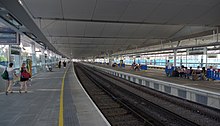
Given the network's success, realised plans arose to upgrade the network to cope with persistent peak-time overcrowding.[18]Network Rail obtained planning permission and legal powers in 2006,[19]funding was secured in July 2007[20]and construction began in October 2007.[21]Plans included rebuilding the station buildings at Farringdon (in conjunction with theCrossrailproject) and West Hampstead Thameslink, total rebuild ofLondon BridgeandBlackfriarsstations, two new underground platforms at St Pancras International, a new tunnel north of St Pancras International to theEast Coast Main Lineto allow through services to Peterborough and Cambridge, and platform lengthening. A new 8- and 12-carriage fleet of Class 700 trains began in 2016. The new services on to theGreat Northern routebegan initially on 8 March 2018,[22]with the full timetable being introduced in May 2018.
The London and South East Route Utilisation Strategy published in July 2011 laid out a provisional 24tphtimetable. South of London it would provide four trains to Brighton (one semi-fast, one stopping) and two each to Three Bridges, Horsham, East Grinstead, Caterham, Tattenham Corner, Tunbridge Wells, Ashford International, Maidstone East, Sevenoaks and Bellingham. North of London there would be eight semi-fast trains to Bedford, four stopping trains to St Albans, two stopping and two semi-fast trains to Luton, two semi-fast trains to Peterborough, two semi-fast trains to Cambridge and four stopping trains to Welwyn Garden City.[23]
Below is a provisional timetable solely for services running through the 'Thameslink core' tunnel. This 'provisional timetable' was proposed before the upgrade and has not yet been achieved. See Services section above for the current service pattern.
| Regional Routes | ||||||||
|---|---|---|---|---|---|---|---|---|
| No. | Northern terminus | Central London | Southern terminus | Length | Times (core) | |||
| 1 | Bedford | semi-fast | viaLondon Bridge | Brighton | fast | 12-car | All day | |
| 2 | ||||||||
| 3 | Bedford | semi-fast | viaLondon Bridge | Gatwick Airport(via Redhill) | semi-fast | 12-car | All day | |
| 4 | ||||||||
| 5 | Peterborough | semi-fast | viaLondon Bridge | Horsham(via Redhill) | semi-fast | 12-car | All day[c] | |
| 6 | ||||||||
| 7 | Cambridge | semi-fast | viaLondon Bridge | Brighton | fast | 12-car | All day[c] | |
| 8 | ||||||||
| 9 | Cambridge | stopping | viaLondon Bridge | Ashford International(peak only) Maidstone East(off-peak) |
semi-fast | 8-car | All day[d] | |
| 10 | ||||||||
| 11 | Bedford | fast | viaLondon Bridge | East Grinstead | stopping | 12-car | Peak only | |
| 12 | ||||||||
| 13 | Bedford | fast | viaLondon Bridge | Littlehampton(via Hove) | fast | 12-car | Peak only | |
| 14 | ||||||||
| Commuter Routes | ||||||||
| No. | Northern terminus | Central London | Southern terminus | Length | Times | |||
| 15 | Luton | all stations[e] | viaLondon Bridge | Rainham(via Greenwich) | all stations[f] | 8-car | All day | |
| 16 | ||||||||
| 17 | St Albans City | all stations | viaElephant & Castle | Sutton(via Mitcham Junction) | all stations | 8-car | All day | |
| 18 | ||||||||
| 19 | St Albans City | all stations | viaElephant & Castle | Sutton(via Wimbledon) | all stations | 8-car | All day | |
| 20 | ||||||||
| 21 | Luton(peak only) Kentish Town(off-peak) |
all stations | viaElephant & Castle | Orpington(via Catford) | all stations | 8-car | All day[g] | |
| 22 | ||||||||
| 23 | Welwyn Garden City(peak only) London Blackfriars(off-peak) |
stopping | viaElephant & Castle | Sevenoaks(via Catford and Otford) | all stations | 8-car | All day[h] | |
| 24 | ||||||||
Rolling stock
[edit]All rolling stock used on Thameslink iselectrically powereddual-voltage units using25 kV ACoverhead power north of Farringdon and 750VDCthird railto the south.[1]
Current fleet
[edit]Class 700
[edit]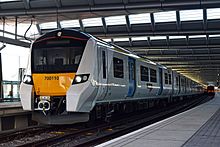
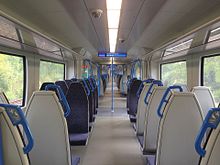
Class 700 trains were delivered between 2015 and 2018, providing an additional 14,500 seats.[clarification needed][24]Siemens Mobilitywas named preferred bidder on 16 June 2011, with theDesiro Citytrain family.[25]The contract was signed in June 2013[26]for 1,140 carriages, with 55 twelve-car and 60 eight-car trains. The depots are atHornseyandThree Bridges.[25]The Three Bridges depot opened in October 2015 and the first trains entered service in spring 2016. All units are now in service, having replaced theClass 319andClass 387fleets.
| Family | Class | Image | Type | Top speed | Number | Carriages | Routes operated | Built | |
|---|---|---|---|---|---|---|---|---|---|
| mph | km/h | ||||||||
| Siemens Desiro | 700Desiro City | 
|
EMU | 100 | 161 | 60 | 8 | All Thameslink services | 2015–2018 |
| 55 | 12 | ||||||||
Past fleet
[edit]Class 319
[edit]
Rolling stock used on Thameslink included the 86Class 319trains built between 1987–1988 and 1990. These areelectrically powereddual-voltage four-car units rated to carry 289, 308 or 319 passengers. Four Class 319 trains had been transferred fromSouthernin December 2008 and the last four followed in March 2009, from which point they were all on Thameslink. The last was withdrawn in August 2017.[27]
Class 377
[edit]First Capital Connect acquired 23 four-coachClass 377sets during 2009 on sublease fromSouthern,for the Thameslink route for additional capacity and to allow some of the Class 319 trains to be released for theCatford Loopservice to Sevenoaks, now jointly operated withSoutheasternunderKey Output 0of the Thameslink Programme.[28]
Class 317
[edit]Class 317units built in the early 1980s were still in use when services into Moorgate ceased in March 2009: the last timetabled service ran from Farringdon to Bedford on 9 October 2009.
Class 387
[edit]Due to delays in the newClass 700fleet, the DfT and Southern ordered 116 electric dual-voltage 110-mile-per-hour (180 km/h) carriages (29 trains) with the option for another 140 carriages (35 trains).[29][30]The tender for the newClass 387trains was won by Bombardier and the first set entered service in December 2014, with all in service by May 2015. By 2018, all units were replaced by the new Class 700 fleet with the Class 387 fleet moving over to theGreat Northernbrand.[31][full citation needed]
2014 franchise
[edit]Theinvitation to tenderfor theThameslink, Southern and Great Northernfranchise was expected to be issued in October 2012, with the contract commencing in September 2013. On 29 March 2012, theDepartment for TransportannouncedAbellio,FirstGroup,Govia,MTR CorporationandStagecoach Grouphad pre-qualified to bid for the franchise.[32]
Due to problems with theInterCity West Coasttendering process, the process was delayed, with the new franchise delayed until September 2014. The new franchise includes theSouth Centralfranchise currently operated by Southern and certain routes from theIntegrated Kent Franchisecurrently operated bySoutheastern.[33]
On 23 May 2014, it was announced that the franchise has been awarded toGovia Thameslink Railway.[34]The new Thameslink Southern & Great Northern franchise[17]will include both the Thameslink Great Northern and South Central franchises.
Govia Thameslink Railway began operations on 14 September 2014, with the formerFirst Capital Connectroutes Thameslink andGreat Northern.
Thameslink 2
[edit]Railfuture,an organisation campaigning for better rail services for passengers and freight, has proposed an additional north–south route, connecting theBrighton Main Lineto routes north of London, viaEast Croydon,Lewisham,Canary Wharf,andStratford.[35]
See also
[edit]- Crossrail– project to build the east–westElizabeth lineroute through London
- West London Line– the North West-South route across London
- Réseau Express Régional(RER) – the similar cross city rail network in Paris
- Cross-City Line– a similar north–south route acrossBirmingham
- Rail transport in Great Britain
Notes
[edit]- ^This service was colloquially known as theBedpanLine from the contracted names of the terminal stations, as had happened with theBakerloo line.In general limited-stop trains served St Pancras, and all-stations trains Moorgate.
- ^King's Cross Thameslinkkept the Thameslink suffix until it closed on 8 December 2007.
- ^abHourly on Sundays.
- ^On Sundays, service will run hourly between Cambridge and Kings Cross only; it will not run through the core section or on to Maidstone.
- ^Except for Kentish Town, Cricklewood and Hendon.
- ^Except for Woolwich Dockyard, Belvedere and Erith.
- ^No service on Sundays.
- ^An all-day service will operate between London Blackfriars and Sevenoaks only, with no service through the core outside of peak hours.
References
[edit]- ^"National Rail Contract Thameslink, Southern and Great Northern"(PDF).Department for Transport. 24 March 2022.Retrieved7 March2023.
- ^abcde"C: Bedford, Luton and St Albans to London, Sutton, the Medway Towns, East Croydon, Gatwick Airport and the South Coast | Timetable valid from Monday 11 December 2023 until Monday 27 May 2024".timetables.thameslinkrailway.Retrieved6 September2022.
- ^ab"Q: London, Croydon and Gatwick Airport to Haywards Heath and Brighton".timetables.thameslinkrailway.Retrieved6 September2022.
- ^"O: London and Croydon to Redhill, Reigate, Tonbridge, Gatwick Airport and Three Bridges".timetables.thameslinkrailway.Retrieved6 September2022.
- ^ab"A: King's Lynn, Ely, Cambridge, Peterborough and Stevenage to London, Gatwick Airport, Horsham and Brighton".Thameslink.Retrieved6 September2022.
- ^"P: London, Croydon and Gatwick Airport to Crawley and Horsham".timetables.thameslinkrailway.Retrieved6 September2022.
- ^abcd"E: Sevenoaks, Swanley, Orpington, Bromley South and Catford to London".
- ^"F: The Medway Towns, Gravesend, Dartford and Woolwich to London and Luton".
- ^ab"H: Sutton and Wimbledon to London via Streatham and Tulse Hill".
- ^"B: Stevenage, Hertford North, Enfield Chase, Welwyn Garden City, Hatfield and Potters Bar to London".
- ^"N: London and Croydon to Oxted, East Grinstead and Uckfield".
- ^Dow, Andrew (1 January 2005).Telling the Passenger Where to Get Off.Capital Transport Publishing. pp. 52–55.ISBN9781854142917.
- ^"Station Name: Snow Hill/Holborn Viaduct Low Level".Disused Stations News.Subterranea Britannica. 8 December 2007.Retrieved17 June2008.
- ^"Sustained Passenger Growth in London"(Press release).Strategic Rail Authority.29 March 1999.Retrieved17 June2008.[permanent dead link]
- ^"Department of Transport announces winner of Thameslink/GN franchise"(Press release).Central Office of InformationNews Distribution Service. 13 December 2005.Retrieved17 June2008.[permanent dead link]
- ^"Letter from TfL to FCC".Narkive.Archived fromthe originalon 12 February 2015.Retrieved12 February2015.
- ^ab"New rail franchising deal set to transform passenger services across London and south east"(Press release). Department for Transport. 23 May 2014.Retrieved11 June2015.
- ^Network Rail."Thameslink Programme".Retrieved18 October2006.
- ^"The £3.5bn Thameslink Project clears major hurdle"(Press release).Network Rail.18 October 2006. Archived fromthe originalon 4 March 2007.Retrieved16 June2011.
- ^Coward, Andy (15 August 2007). "Cross-river rail to boost Capital".Rail Magazine.No. 572. Peterborough. pp. 40–43.
- ^ "Work begins on Thameslink project".BBC News.24 October 2007.Retrieved24 October2007.
- ^"First direct trains from Cambridge to Brighton via central London launch".Evening Standard.8 March 2018.Retrieved5 March2022.
- ^London and South East Route Utilisation Strategy(PDF)(Report). p. 72. Archived fromthe original(PDF)on 13 December 2013.
- ^"Thameslink gets 14,500 more seats".BBC News.9 April 2008.Retrieved1 June2008.
The deal, announced by Transport Secretary Ruth Kelly, will mean the current 720-carriage Thameslink fleet increasing by 380 carriages. A contract for the new carriages is expected to be awarded in summer 2009, with the first train in service by 2012.
- ^ab"Siemens beats Bombardier to Thameslink train order".Railway Gazette International.London. 16 June 2011. Archived fromthe originalon 19 June 2011.Retrieved16 June2011.
- ^"Siemens Thameslink deal to create up to 2,000 new jobs".Department for Transport. 27 June 2013.
- ^"Thameslink replaces last of 30 year old Class 319 fleet".Rail Technology Magazine. 1 September 2017. Archived fromthe originalon 15 September 2017.
- ^"Do we really have to wait until 2012 and 2015 for some relief to the overcrowding?".First Capital Connect.20 October 2008. Archived fromthe originalon 9 November 2008.Retrieved28 October2008.
- ^"Boost to train builders".Department for Transport. 21 December 2012.Retrieved23 May2014.
- ^"Procurement of New Rolling Stock"(Press release). Archived fromthe originalon 29 March 2013.
- ^"Trio of GTR Class 387/1s readied for move to Great Northern duties".Rail Magazine.16 July 2016.
- ^"UK franchise pre-qualified bidders announced".Railway Gazette International.London. 29 March 2012.
- ^"Thameslink Southern & Great Northern Invitation to Tender"(PDF).Department for Transport. 26 September 2013.
- ^"Govia wins Thameslink rail franchise".BBC News.28 January 2014.Retrieved23 May2014.
- ^"Railfuture – Thameslink 2".
Further reading
[edit]- Freitag, Leslie (August 1988). "Thameslink underway".RAIL.No. 83. EMAP National Publications. p. 11.ISSN0953-4563.OCLC49953699.
External links
[edit] Media related toThameslinkat Wikimedia Commons
Media related toThameslinkat Wikimedia Commons
- Thameslink
- Airport rail links in London
- Transport in the London Borough of Barnet
- Rail transport in Bedfordshire
- Transport in Brighton and Hove
- Transport in the London Borough of Camden
- Transport in the City of London
- Transport in the London Borough of Croydon
- Rail transport in East Sussex
- Rail transport in Hertfordshire
- Transport in the London Borough of Islington
- Transport in the London Borough of Lambeth
- Transport in the London Borough of Merton
- Transport in the London Borough of Southwark
- Rail transport in Surrey
- Transport in the London Borough of Sutton
- Rail transport in West Sussex
- Transport in Luton/Dunstable Urban Area
- Transport in Bedford

